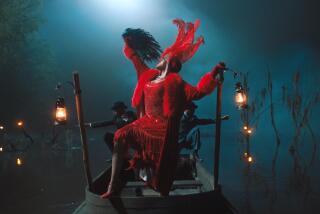Dance Review : Shades Overshadow Stars in ‘Bayadere’
It is often said of the Kingdom of the Shades scene in “La Bayadere” that the corps de ballet is the real star, with each dancer etching crystalline shapes that mesmerize when multiplied.
The geometric precision of white veiled arms and slowly extended legs creates the icy melancholy of a poetic “beyond” in which separated lovers meet again. Nevertheless, it’s the soloists who continue to be featured in prominent type on the program and to be paid more for dancing in front. That’s how it works.
And there’s no doubt American Ballet Theatre has worthy principal dancers. But the corps was where to put your money on Thursday night, as the second evening of a mixed program unfolded at Orange County Performing Arts Center in Costa Mesa.
“Cruel World” and “In the Upper Room” (reviewed Friday) were again preceded by the “Bayadere” excerpt, this time featuring Cynthia Harvey and Guillaume Graffin as the doomed lovers Nikiya and Solor.
Technically, Harvey and Guillaume were strong with only a few tangles with gravity: she, trying to launch some tricky releve turns; he trying to land a series of double tours. Recovery was swift, and Guillaume’s airy leaps and balanced turns were matched in energy and elan by Harvey’s measured extensions and perfectly poised pirouettes.
However, where perfect poise suits the unison work of the corps, the doomed lovers need more deeply felt passion, notoriously difficult to develop in short bursts on mixed programs.
Perhaps, without earlier scenes to establish character, Harvey and Guillaume became preoccupied with the pristine layer of containment required for 19th-Century balletic passion. What was missing was the requisite restraint that trembles with inchoate emotions.
The first Shadow variation was crisply danced by Ashley Tuttle, the second given sweeping dimensions by Shawn Black. With enviable balance, a keenly focused gaze and sparkling runs on pointe, Veronica Lynn made the third Shadow the most substantial of the evening.
That is, if you’re not counting the corps, the “stars” who also stand and wait. During the curtain call, as is traditional with “Bayadere,” the corps received shouts and applause at a level normally reserved for principals.
More to Read
The biggest entertainment stories
Get our big stories about Hollywood, film, television, music, arts, culture and more right in your inbox as soon as they publish.
You may occasionally receive promotional content from the Los Angeles Times.










